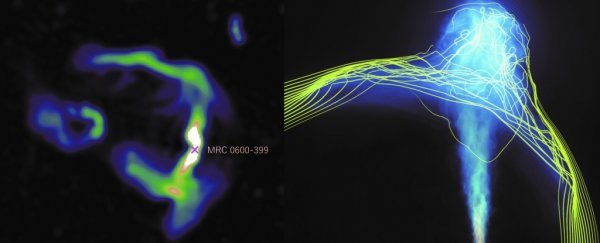In a galaxy cluster called Abell 3376, some 600 million light-years from Earth, one galaxy has an active supermassive black hole, gobbling up matter at a furious rate – a process that blasts powerful jets of plasma hundreds of thousands, sometimes even millions, of light-years into intergalactic space.
Astronomers have now found that, at a certain distance from the black hole, these jets are being bent at a right angle by powerful intergalactic magnetic fields.
That galaxy is called MRC 0600-399, and its jets were already known for their bizarre, bent shape.
But this new research supports the idea that this is the result of complex magnetic fields generated by interactions between galaxies in the cluster and the intergalactic medium.
Intracluster magnetic fields can reveal a lot about galaxy clusters, such as how they grow, and the impact they have on the clusters themselves. However, these magnetic fields are difficult to observe directly.
This new discovery suggests a way we can now study them.
When something interacts with a magnetic field, it’s possible to make out details – and, as it turns out, black hole jets can delineate magnetic fields beautifully.
Black hole jets are fascinating structures. Nothing that we can currently detect can escape a black hole once it’s passed the critical proximity threshold, but not all the material in the accretion disk swirling of material into an active black hole inevitably ends up beyond the event horizon.
A small fraction of it somehow gets funneled from the inner region of the accretion disk to the poles, where it is blasted into space in the form of jets of ionized plasma, at speeds a significant percentage of the speed of light.
Astronomers think that the black hole’s magnetic field plays a role in this process. The magnetic field lines, according to this model, act as a synchrotron that accelerates material before launching it at tremendous speed. From there, these highly collimated jets, thought to be shaped by magnetic fields, can extend vast distances into intergalactic space.
They’re detectable in radio wavelengths, and we’ve found a fair few of them. But the shape of the jets from MRC 0600-399 is really unusual, so an international team of scientists decided to take a closer look, using the powerful MeerKAT radio telescope in South Africa.
Equipped with the new observations, much higher resolution than previously obtained, the researchers were able to study the jets in unprecedented detail.
The images showed that the jets bend at almost 90-degree angles, as had been previously observed. Strikingly, though, the images also show diffuse regions of radio emission at both sides of the point at which the jet bends, creating a T-shape, which the researchers refer to as ‘double-scythe’.
Next, the team ran simulations to try to reproduce the shape of the jet. They showed that a black hole jet traveling at supersonic speeds colliding with a curved layer of magnetic field that it couldn’t penetrate could reproduce the observed shape of MRC 0600-399’s jets.
Much like a stream of water striking a hard surface, this collision would be chaotic and messy.

Above: The bent jet structures as observed by MeerKAT (left). On the right are simulations showing how magnetic fields could be causing these shapes.
It’s not the only explanation. Another is that MRC 0600-399 may be currently falling back towards the center of Abell 3376, after being kicked out at supersonic speed.
The bending of the jets could have been caused by ram pressure from the surrounding intergalactic gas. Even if this is the case, though, it can’t explain all of the features of the bent jets, including the double-scythe structures, so the presence of a magnetic field is likely still necessary.
It’s an exciting finding because it demonstrates the presence of strong, well-ordered magnetic fields inside galaxy clusters, environments that are often complicated and unkempt. This could help better understand galaxy cluster dynamics.
It also shows that black hole jets can be used as an excellent tool for understanding mysterious, hard-to-see magnetic fields in deep space.
And perhaps not least, the research may even be able to help astronomers better understand how magnetic fields can shape and guide the powerful plasma jets blasting out of active supermassive black holes.
The research has been published in Nature.



